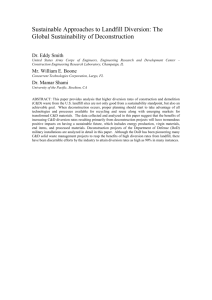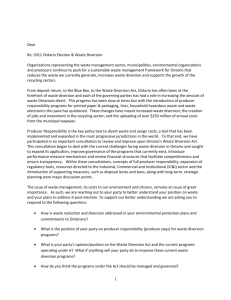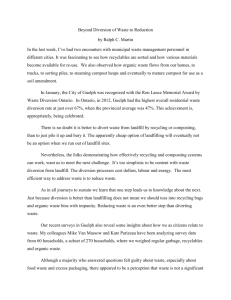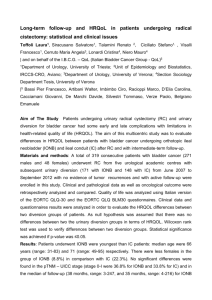Oregon Wine Advisory Board Research Progress Report 1991
advertisement
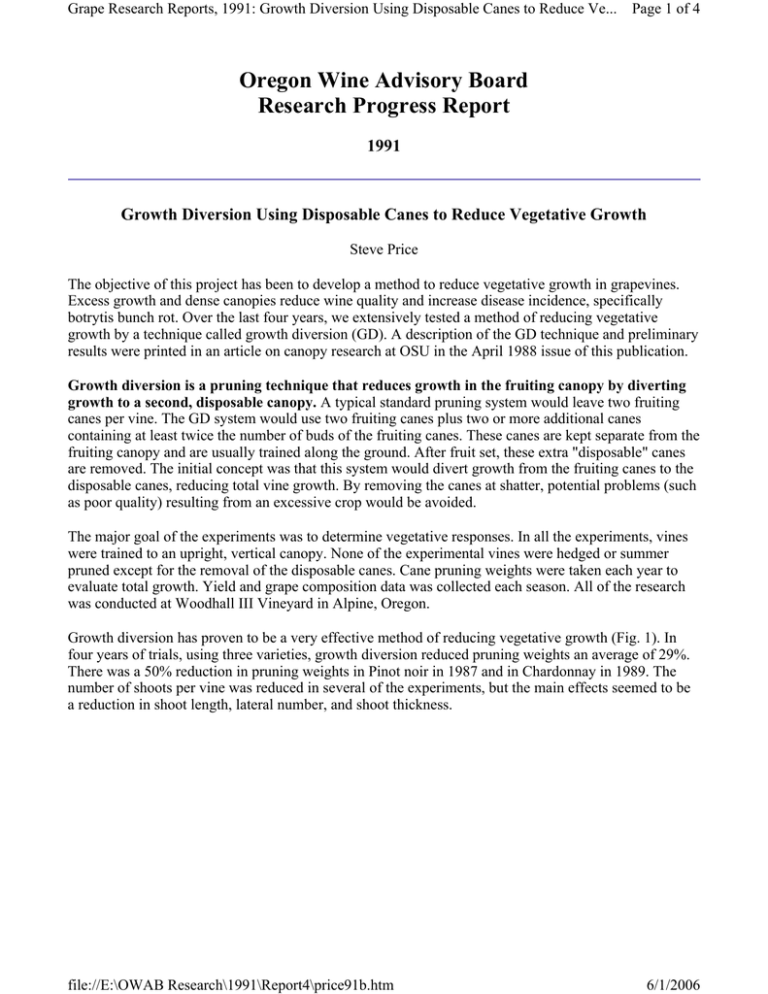
Grape Research Reports, 1991: Growth Diversion Using Disposable Canes to Reduce Ve... Page 1 of 4 Oregon Wine Advisory Board Research Progress Report 1991 Growth Diversion Using Disposable Canes to Reduce Vegetative Growth Steve Price The objective of this project has been to develop a method to reduce vegetative growth in grapevines. Excess growth and dense canopies reduce wine quality and increase disease incidence, specifically botrytis bunch rot. Over the last four years, we extensively tested a method of reducing vegetative growth by a technique called growth diversion (GD). A description of the GD technique and preliminary results were printed in an article on canopy research at OSU in the April 1988 issue of this publication. Growth diversion is a pruning technique that reduces growth in the fruiting canopy by diverting growth to a second, disposable canopy. A typical standard pruning system would leave two fruiting canes per vine. The GD system would use two fruiting canes plus two or more additional canes containing at least twice the number of buds of the fruiting canes. These canes are kept separate from the fruiting canopy and are usually trained along the ground. After fruit set, these extra "disposable" canes are removed. The initial concept was that this system would divert growth from the fruiting canes to the disposable canes, reducing total vine growth. By removing the canes at shatter, potential problems (such as poor quality) resulting from an excessive crop would be avoided. The major goal of the experiments was to determine vegetative responses. In all the experiments, vines were trained to an upright, vertical canopy. None of the experimental vines were hedged or summer pruned except for the removal of the disposable canes. Cane pruning weights were taken each year to evaluate total growth. Yield and grape composition data was collected each season. All of the research was conducted at Woodhall III Vineyard in Alpine, Oregon. Growth diversion has proven to be a very effective method of reducing vegetative growth (Fig. 1). In four years of trials, using three varieties, growth diversion reduced pruning weights an average of 29%. There was a 50% reduction in pruning weights in Pinot noir in 1987 and in Chardonnay in 1989. The number of shoots per vine was reduced in several of the experiments, but the main effects seemed to be a reduction in shoot length, lateral number, and shoot thickness. file://E:\OWAB Research\1991\Report4\price91b.htm 6/1/2006 Grape Research Reports, 1991: Growth Diversion Using Disposable Canes to Reduce Ve... Page 2 of 4 Yield was not affected by GD in any of the experiments. However, an increase in berries per cluster and seeds per berry was observed in 1987 on Pinot noir, along with a decrease in berry size. There were variable effects on grape composition. Brix was not greatly changed in these trials. Growth diversion lowered the pH in Pinot noir, and in Chardonnay it reduced TA. Wine was not made from any of these experiments, but with the large change in canopy density and the change in acidity, it is likely that wine characteristics would be affected by GD. In other canopy trials at OSU, treatments that reduced canopy density usually increased color, even if brix, TA, and pH were not affected. This project was concluded this year with two large experiments: one on the effects of the number of nodes left on the disposable canes and a second on the timing of disposable cane removal. These data have not been completely analyzed. Visual observations during the growing season suggest that both timing and bud number have major effects on vine growth responses. The concept of growth reduction though growth diversion was more successful than we anticipated. At Woodhall III Vineyard it was a very effective way to improve canopy density. It is not appropriate, however, for Oregon growers to assume that this system will solve all their canopy problems. But the system has been too effective in our trials to dismiss it as just another odd idea from the "academic types". It is a promising concept that needs to be approached with a degree of caution. First, there are several questions about growth diversion that our experiments did not address. The most important is how the system would perform on a very vigorous site. It's possible that on a site with very deep soil, or a site where water is available throughout the season, that GD would not give an adequate reduction in growth. At a site like Woodhall, where vigor is only slightly more than desirable, it's possible that continued use of the system would be too devigorating. In our trials, vines were only "subjected" to vigor diversion for one season and different vines used for the next season's experiment. It's probable that the GD system will have to be adjusted to each site. There are three points that came out of these trials that are clear and they are points Oregon growers should note: file://E:\OWAB Research\1991\Report4\price91b.htm 6/1/2006 Grape Research Reports, 1991: Growth Diversion Using Disposable Canes to Reduce Ve... Page 3 of 4 1. The growth diversion experiments illustrated an important point about vine growth. The growth of individual shoots is largely a function of how many shoots are growing on the vine. Growth diversion reduces individual shoot growth by greatly increasing the total shoot number per vine. This same concept is evident in many other viticultural practices from vine response to light pruning to the growth responses of vines with divided canopies. These experiments also illustrated that under typical Oregon conditions, the high shoot numbers do not have to be present the whole season to get the desired growth reduction. 2. Growth diversion is one of the easiest ways to test a vineyard's response to a lower canopy density. This system allows a grower to modify vine growth without going to the expense of changing trellis systems or even changing crop load. If vines respond to growth diversion with an improvement in acidity, sugar, color, yield, or botrytis incidence, then the vineyard has a canopy density problem and permanent remedies should be considered. 3. The concepts inherent in growth diversion could be used with a Scott Henry trellis system both to reduce vigor and to regulate yield levels. We have started a set of experiments to evaluate the Scott Henry trellis with one modification--we are treating the lower canopy of the trellis as "potentially disposable". In a vigorous vineyard, the lower cane on the Scott Henry system can be treated like the disposable cane of the GD system. In a normal year it can all be disposed of after shatter but in a year with poor fruit set, part or all of it could be retained to achieve an acceptable yield. This system would reduce growth every year and it offers a more cost effective way of adjusting yields than cluster thinning. Growers interested in experimenting with growth diversion are encouraged to call Steve Price, Bernadine Strik, or Porter Lombard at Oregon State University. We would be glad to help set up grower trials to test this system in a range of Oregon conditions. A grower interested in testing this system in their vineyard should be looking for the answers to three key questions: Does it reduce growth? Does the growth reduction improve fruit composition or disease incidence? Are the benefits worth the added management expense? The role of the OSU research program in this project has been to develop a new technique to deal with a common problem and to test its potential. We can assist in the next step of finding applications for the concept, but the final step of fitting the technique into a usable, profitable management technique is the grower's responsibility. GROWER EXPERIENCES WITH GROWTH DIVERSION Several growers in Oregon and California have experimented with the growth diversion system. The following is a brief description of their experiences. Cooper Mountain Vineyard: Corine and Bob Gross experimented with growth diversion on an experimental basis in 1988. They found that the system generally worked well and did reduce vine vigor. They were pleased with the resulting wines, but they found the system to be a bit of a management problem. They did not use the system in 1989 or 1990. Tualatin Vineyards: Dave Foster, vineyard manager at Tualatin, used the growth diversion pruning system on all 70 acres of Tualatin vineyard this year. He is looking for an alternative to repeated hedging and leaf removal. He estimates that leaving the additional disposable canes during pruning took an extra five hours per acre. file://E:\OWAB Research\1991\Report4\price91b.htm 6/1/2006 Grape Research Reports, 1991: Growth Diversion Using Disposable Canes to Reduce Ve... Page 4 of 4 Robert Mondavi Winery: Andy Bledsoe, a researcher for Mondavi, tried growth diversion in a vigorous block of Sauvignon blanc. They left two fruiting canes per vine and left 2, 4, 6, and 8 disposable canes per vine. The system reduced vegetative growth but there was no difference in fruit brix, TA, or pH. The following year the vines were pruned normally but there was a carry-over effect. Vines that had been pruned with the vigor diversion system the previous year had less growth. The effect was more pronounced on the vines that had had more disposable canes. They are going to try the system again, but this time on a red variety. Domaine Chandon: Zack Berkowitz, vineyard manager for Domaine Chandon, tried growth diversion on Pinot noir and Chardonnay in Carneros in 1989. They found the system to be difficult to manage and did not get much of a response. They politely blamed some of this on their management problems, but they have not tried the system again. file://E:\OWAB Research\1991\Report4\price91b.htm 6/1/2006
